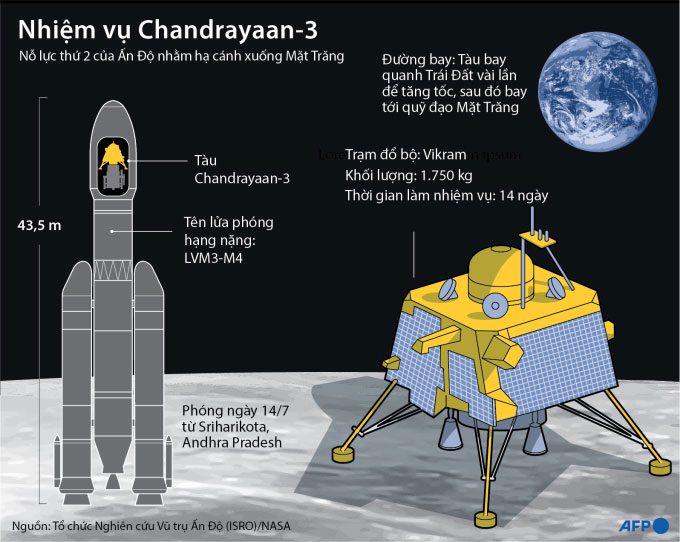The Vikram lander of the Chandrayaan-3 mission successfully landed in the vicinity of the Moon’s south pole at 7:34 PM on August 23 (Hanoi time).
The moment the Indian lander touched down on the Moon’s surface. (Video: ISRO)
The Indian Space Research Organisation (ISRO) activated the automatic landing mode at 7:14 PM (Hanoi time). There was no ground control intervention when the automatic landing sequence began. The lander commenced its landing process at 7:15 PM (Hanoi time), gradually decreasing altitude to softly touch down near the Moon’s south pole. The final minutes of the Moon landing are referred to as “the 15 minutes of terror.”
This process consists of four stages:
- The first is the rapid deceleration phase. During this phase, the horizontal speed of the lander decreases from approximately 6,000 km/h to nearly 0 km/h for a gentle landing.
- Next is the posture hold phase at an altitude of about 7.43 km above the Moon’s surface. At this point, the lander will rotate from a horizontal position to vertical while moving 3.48 km.
- The third phase is the gentle braking phase, lasting approximately 175 seconds. During this time, the lander will move about 28.52 km (horizontally) towards the landing site while reducing its altitude to around 1 km. Previously, Chandrayaan-2 lost control between phases 2 and 3.
- The final phase involves lowering altitude to land on the surface, with the lander in a completely vertical position gradually touching down on the Moon.
“Witnessing such historical moments makes us very proud. This is the dawn of a new India. No country has ever reached this area (the Moon’s south pole). With the efforts of our scientists, we have made it there,” Prime Minister Modi shared as Chandrayaan-3 successfully landed.

Simulation of the Vikram lander and Pragyan rover in the Chandrayaan-3 Moon mission. (Photo: ISRO)
The success of Chandrayaan-3 makes India the fourth country in the world to land on the Moon’s surface, following the Soviet Union, the United States, and China. This mission also marks India’s emergence as a new space power. Indian Prime Minister Narendra Modi is looking to boost investment in private space launches and satellite-related business activities. India aims for its private space companies to increase their share of the international launch market fivefold over the next decade.
The first Moon mission in India’s Chandrayaan program was Chandrayaan-1, launched in 2008. This mission included an orbiter circling the Moon at an altitude of 100 km to map its geology, mineralogy, and chemistry. After the spacecraft completed all primary mission objectives, the orbit was raised to 200 km in May 2009. The mission ended when contact was lost with it in late August 2009.
In 2019, India launched the Chandrayaan-2 mission to attempt a Moon landing but faced failure. The lander and rover were destroyed upon crashing near the intended landing site of Chandrayaan-3. Meanwhile, the Chandrayaan-2 orbiter was successfully deployed and is still orbiting the Moon.
On July 14 of this year, the Vikram lander of Chandrayaan-3 was launched from the Satish Dhawan Space Centre, continuing the ambition to land on the Moon. The lander gradually increased altitude and ignited its engines on July 31 to head towards the Moon. It entered lunar orbit on August 5.
Vikram targeted the Moon’s south pole, an area of significant interest due to the potential presence of water ice, which could be used as fuel or to sustain life. Although not landing directly at the south pole, India planned to land further south than any previous missions. Landing near the equator is generally considered easier due to various technical reasons related to light, communication, and terrain.
Vikram stands about 2 meters tall and weighs over 1,700 kg, including the 26 kg Pragyan rover it carries. A significant portion of Vikram’s mass consists of propellant. Both Vikram and Pragyan are solar-powered, with an expected operational period of one lunar day (approximately 14 Earth days) before the harsh and cold lunar night sets in, depleting their batteries. This duo will conduct a series of experiments, including spectroscopic analysis of the lunar surface’s mineral composition.

Information about India’s Chandrayaan-3 Moon mission. (Graphic: AFP).
Vikram carries four scientific instruments, including a thermal probe capable of penetrating the lunar soil about 10 cm to record temperature variations throughout the lunar day. The lander is also equipped with a retroreflector, expected to remain functional long after the lander ceases operations. Meanwhile, the Pragyan rover is equipped with a Laser-Induced Breakdown Spectroscopy (LIBS) and an Alpha Particle X-ray Spectrometer (APXS) to study lunar rocks and soil.
Lunar landings are not easy. Another spacecraft targeting the region near the Moon’s south pole, Russia’s Luna-25, failed when it crashed on the Moon’s surface on August 20. Japan’s private space startup ispace also failed in its attempt to land on the Moon last April.


















































